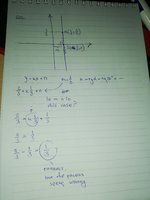Ana.stasia
Junior Member
- Joined
- Sep 28, 2020
- Messages
- 118
The question is:
Determine the equation of a line that contains a point (1/3, 2/3) and is parallel to the ordinate axis.
This is how I tried to do it. I got 1/3. The result says it should be x=1/3. Although it's similar the whole process seems wrong. Especially the 2/3=1/3 part.
Determine the equation of a line that contains a point (1/3, 2/3) and is parallel to the ordinate axis.
This is how I tried to do it. I got 1/3. The result says it should be x=1/3. Although it's similar the whole process seems wrong. Especially the 2/3=1/3 part.

